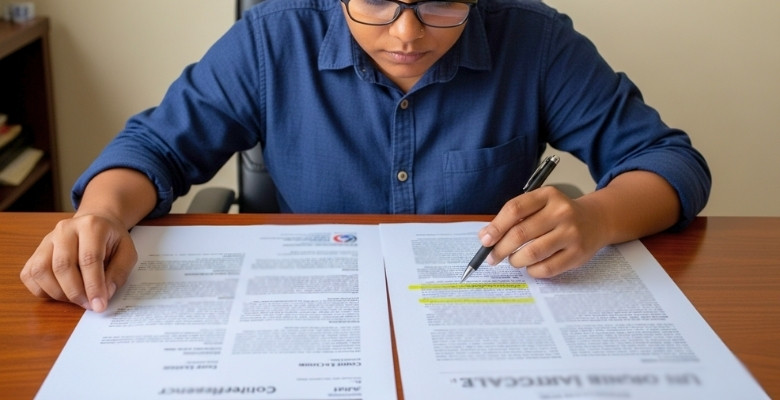Writing a computer engineering research paper is a smart way to share new ideas and discoveries in technology. Publishing that paper in a journal makes your work available to others and helps it reach a bigger audience. If you’ve been working on a new tech idea or solution, you might be thinking about: How to Publish a Computer Engineering Research Paper in a Journal?
Start by doing original research on a new or useful idea. Choose a journal that fits your topic. Follow the journal’s format to write the paper clearly. Write a short cover letter, submit everything online, wait for expert review, make the changes they suggest, and then your paper can get published.
Do you want to know each step in a simple way, from writing your paper to sharing it with the world? Or are you curious about how journals work or what happens after you send your paper? Then keep reading—this article has all the answers you’re looking for.
How to Publish a Computer Engineering Research Paper in a Journal?
Publishing a computer engineering research paper in a journal might sound like a big thing, but it’s actually a step-by-step process. You don’t have to be an expert to do it. With a little effort, anyone can try. If you’re curious about how it all works, keep reading to learn more.

Do Original Research
To begin, you need to think of a fresh and useful idea in computer engineering. This could be about software, hardware, or solving a tech problem people often face. Try to test your idea using coding, simulations, or even by building something small. Write down everything clearly—your methods, your results, and what they mean. The key is to come up with something new that others haven’t done yet.
Choose the Right Journal
When your research is finished, look for a journal that covers your topic. Not every journal is the same, so you want one that often publishes papers like yours. See if it’s open access or needs a subscription. Reviewing papers presented during events like tech expos or conferences in USA can also help you understand which journals accept research like yours. It’s a simple way to find where your paper might fit best.
Write Your Paper
Each journal has its own format, so follow its rules when writing. Use simple and clear words to explain your idea. Include all the main parts like title, abstract, introduction, methods, results, and conclusion. Add clear tables, charts, or diagrams if needed. Keep your writing neat so anyone reading it can understand what you did and why it matters.
Write a Cover Letter
Before sending your paper, write a short letter to the journal editor. In this letter, explain what your research is about and why it is important. Say how your work matches the journal’s topic. Also, clearly state that the paper is original and not being sent anywhere else. Keep the tone respectful and professional.
Submit Everything Online
Most journals ask you to submit papers through their website. You’ll need to upload your paper, any images, and extra files if needed. Fill in your name, email, and other author details. Also, add a few keywords that match your topic. Some journals might ask for a fee, so be prepared for that. Double-check everything before you hit the submit button.
Wait for Review
Once you submit your paper, it goes to experts who check if it’s clear, correct, and useful. These experts will send feedback with tips or changes you might need to make. Don’t feel upset if you get some criticism—this is a normal part of the process. The review is meant to make your paper even better before it’s published.
Make Changes
Use the feedback to improve your paper. If they ask for changes, update your paper and write a short letter explaining what you changed. If you didn’t follow a suggestion, explain why. Try to send the new version on time. You may have to do this more than once, but it’s all part of making your work ready to share.
Last Steps
Whenever your paper is accepted, it goes through final editing. You may be asked to check a “proof” copy to find small mistakes like spelling or missing words. After that, your paper will be published in the journal, either online or in print. People can now read it, use your ideas, or even build on your work.
Share Your Work
After getting published, tell others about your paper. You can post it on science or tech websites or share it with people who are interested. Talking about it at events or meetups also helps. When more people read your work, it can open new doors and help you find others who are working on similar things.
How Conference Papers Differ From Journal Submissions?
Many people think conference papers and journal papers are the same, but they are actually quite different. Both are ways to share ideas, but they work in different ways. They have different rules, styles, and goals. Let’s look at the main differences and understand them better.
Time and Deadlines
The deadlines for conference papers are strict. If you miss the date, you’ll have to wait for the next event. Journal papers don’t always have fixed dates, so you can send them when you’re ready. But journals can take longer to review your work. So, one is faster, and the other gives more time.
Length and Details
Conference papers are usually shorter. They focus on the main idea and important results. Journal papers are longer and go deeper into the topic. You need to explain more, add more data, and cover everything clearly. So, journal papers need more writing and more details.
Review Process
Papers are checked quickly by a small group of reviewers at conferences. They look for clear ideas and if the topic fits the event. Journal papers go through a slower review by experts who check everything closely. This makes journal reviews more detailed and sometimes harder to pass. Both want good work, just in different ways.
Purpose and Use
Conference papers are great for sharing new ideas quickly and getting feedback. It’s like a test run for a bigger project. Journal papers are used to show full and final work after everything is tested. Many people use journal papers for future research. Both are useful, just for different reasons.
Where It’s Shared
During live events where participants discuss their work, conference papers are shared. You may even present your paper in front of others. Journal papers are printed or posted online in journals and stay there for a long time. People can read them anytime, even years later. So, journals last longer while conferences are more about now.
Style of Writing
Conference papers often use a simple style to fit a short time and space. You need to get to the point fast. For example, if you are writing a Computer Engineering Conference Paper, you should focus on clear ideas, short explanations, and strong results. Journal papers use a more careful style with more examples, proofs, and clear steps. You have more room to explain things, so your writing style depends on where you’re sending it.
Is It Difficult to Choose the Right Journal for Your Computer Engineering Research?
Yes, it can be difficult to choose the right journal for your computer engineering research, especially if you are new. Many journals look similar, but not all will match your topic or idea. Some focus on software, others more on hardware issues. You need to find one that often publishes work like yours. It takes time and careful reading to make the right choice.
Some journals are open to new ideas, while others need deeper research results. You must check the journal’s aim and recent papers. That helps you see if your research fits well or not. Look for journals that have published papers close to your topic before.
It’s also good to check if the journal is open access or needs a subscription. Some charge money to publish your paper. Others may take longer to reply with results. Reading conference papers or journal names from tech events can also guide you well.
Formatting and Submission Requirements for Computer Engineering Papers in Journals
Before sending your computer engineering paper to a journal, it’s important to follow its specific rules. Each journal has its own format and style. Here’s a simple table showing the common things you need to take care of:
| Aspect | Details |
| Title Page | Should include the paper title, author names, affiliations, and contact info. |
| Abstract | A short summary of the paper, usually 150–250 words, is placed after the title. |
| Keywords | 3–6 important words related to your topic, listed below the abstract. |
| Font and Spacing | Most journals ask for 12-point font, double-spaced lines, and clear headings. |
| Section Headings | Use headings like Introduction, Methods, Results, and Conclusion in order. |
| Figures and Tables | Must be numbered, labeled clearly, and placed close to where they are discussed. |
| References | Follow the citation style asked by the journal (like IEEE or APA). |
| File Format | Usually PDF or Word file; follow the journal’s upload instructions. |
| Word Limit | Some journals have a maximum word count; check their guidelines before writing. |
| Cover Letter | A short letter to the editor explaining the paper’s topic and importance. |
Common Reasons Why Computer Engineering Papers Get Rejected
Rejection can feel disappointing, but it’s a part of the process when submitting a research paper. It usually happens for clear and fixable reasons. Knowing what causes rejection can help you avoid it next time. Below are some common reasons why computer engineering papers get rejected, so you can stay prepared:
No New Idea
Sometimes a paper gets rejected because it doesn’t bring anything new to the table. If the topic has already been covered many times, editors may skip it. It’s important to offer a fresh idea or a new way of solving a problem. Even a small change or improvement can make your paper stand out. Try to ask, “What makes this paper special?”
Weak Method Used
If your method is not clear or strong enough, reviewers may not trust your results. A good method means showing how you tested or built something step by step. You should also explain why you chose that method. Missing steps or poor planning can make your work look unfinished. Reviewers want to see that your idea was tested properly.
Not Enough Data
Data helps prove your point. If your paper has very little data, it may seem incomplete. You need to show results with tables, charts, or graphs to back up what you’re saying. Without that, it’s hard for people to believe your work. Strong data makes your paper more solid.
No Deep Analysis
Just collecting data isn’t enough; you have to explain what it means. Some papers get rejected because they don’t go beyond simple facts. Reviewers want to see how your results match or change what others have found. You should explain why your results matter. Think more and write clearly about what your data shows.
Poor Writing Style
Even good ideas can be lost in messy writing. If your paper has grammar mistakes, unclear sentences, or no structure, it gets hard to read. Reviewers might give up halfway. Make sure your paper is clean, simple, and easy to follow. Good writing helps your ideas shine.
Ignoring Comments
Sometimes, a paper is sent back with helpful comments, but the writer doesn’t make the changes. This is a common reason for rejection. You should read each comment and fix the problems they pointed out. If you disagree, explain why in a kind way. Reviewers want to see that you’re open to feedback.
Wrong Journal Picked
Choosing the wrong journal is another reason papers get turned down. Some journals focus only on certain topics. If your paper doesn’t match, they might reject it without reading much. Always read the journal’s aim before sending your paper. Make sure your topic fits what they usually publish.
How to Reference Properly in a Computer Engineering Journal?
Every strong paper includes clear references to the sources behind its ideas and facts. This practice, known as referencing, builds trust and shows respect for original work. It also helps readers trace the information and understand the depth of your research. Here’s what you need to know to do it correctly.
What Referencing Means
Referencing means giving credit to the source of information you used in your paper. It can be a book, website, journal, or another paper. If you don’t add a reference, it may look like you copied someone’s work. Always mention where the idea came from. This makes your work honest and clear.
Why It Matters
If you reference properly, it shows that your ideas are supported by real research. Readers can see you’ve done the work and can follow your sources for more details. This builds trust and makes your paper stronger in the eyes of both editors and reviewers.
Common Styles Used
Different journals ask for different reference styles. Some popular ones are IEEE, APA, and MLA. In computer engineering, IEEE is used the most. Each style has its own rules about how to write the author’s name, title, and year. Always check the journal’s guide before you start.
How to Add Them
When you use someone’s idea, put a small number or name in the text. That tells the reader there’s a source listed below. Then, at the end of the paper, add full details about that source. Include things like the title, author, and where you found it. Keep the format the same for each one.
Tools You Can Use
You don’t have to do it all by hand. There are tools like Google Scholar, Zotero, and Mendeley that help you make references. You can copy the format directly from these tools. Some journals also have their own online reference makers. These can save you time and help you avoid mistakes.
Check Before You Submit
Before sending your paper, review every reference carefully. Make sure they match the format the journal asks for. Double-check spelling, dates, and order. Even small mistakes can make your paper look unprofessional. A quick check at the end can save you from rejection.
What to Do After Your Paper Is Accepted by a Journal?
Getting your paper accepted is a big moment and a sign that your hard work has paid off. But the process doesn’t end there. There are still a few important steps you need to follow. Let’s explore what happens next and what you should do.
Read the Acceptance Email
Acceptance of your paper is usually followed by an email from the journal outlining what comes next. This message may include submission guidelines, forms to complete, and deadlines to meet. Take time to read everything carefully and make note of any required actions.
Sign Copyright Form
Most journals will ask you to sign a copyright form. This form says you give the journal permission to publish your paper. Read it before signing so you understand what it means. Sometimes, you still keep the rights to your work. Ask the journal if you’re unsure about anything.
Check the Proof Copy
The journal will send you a proof version of your paper. This is the final layout before it goes public. You should check for small mistakes like spelling or missing words. If you see any errors, tell the editor quickly. This is your last chance to fix things.
Wait for Final Posting
After you send back the corrected proof, the journal will prepare your paper for posting or printing. This can take a few days or even weeks. Be patient while they complete this step. Soon, your paper will be online or in the printed journal.
Share Your Paper
Once it’s published, you can start sharing your paper. Send it to friends, teachers, or anyone who might be interested. Post the link on websites or social platforms. The more people who read it, the better. Sharing helps others learn from your work.
Keep a Copy Safe
Download a copy of your published paper and keep it in a safe place. You may need it for future projects. It’s also good to keep the acceptance email and any forms. These papers can be useful later. Saving everything helps you stay organized.
Should You Present at a Conference Before Submitting to a Journal?
Yes, presenting at a conference before submitting to a journal can be a smart and helpful step for many researchers. It gives you a chance to share your work early and hear what others think. This feedback can help improve your paper before journal submission. You also get to meet people who work on similar ideas. These talks often lead to better and clearer writing later on.
Many researchers choose to submit a research paper to a computer engineering conference first for this reason. Conferences usually have faster reviews and give quick replies. You may also find questions you didn’t think about before. Fixing small issues early can make your journal paper stronger and more complete.
Sharing at a conference doesn’t stop you from publishing in a journal later. Most journals allow you to update and expand the work. Just make sure you follow the rules of both the conference and the journal. Doing both steps can give your research more reach and value.
Frequently Asked Questions
Once you understand the main process of publishing a computer engineering research paper, you may still have smaller questions in mind. These common doubts can pop up before, during, or even after your paper is submitted. Below, you’ll find clear answers to some of the most frequently asked questions to guide you further.
How Long Should a Computer Engineering Research Paper Be?
Most computer engineering research papers are between 4,000 to 8,000 words, but it depends on the journal’s rules. Some may allow shorter or longer papers. Always check the word limit before writing. Try to include enough detail while staying focused.
Can I Use Online Sources in My References?
Yes, you can use online sources if they are reliable, like published research papers or official websites. Don’t use random blogs or forums. Always include the full link and access date. Make sure the journal allows web references in its format.
Is It Okay to Use Graphs and Images?
Yes, adding graphs and images helps explain your ideas better. They should be neat, labeled clearly, and placed near the related text. Use high-quality files like PNG or JPG. Mention the source if you didn’t create the graph yourself.
What Happens If My Computer Engineering Research Paper Has Plagiarism?
If any part of your computer engineering research paper is copied without a proper reference, it may be rejected for plagiarism. So you need to check this before the review. Always write in your own words and use references when needed. Even self-copying from your past paper can be a problem.
How Do I Choose Keywords for My Paper?
Choose 3–6 words or short phrases that match your paper’s topic. Think about what someone might search for to find your paper. Use words from your title or abstract. Good keywords help your paper appear in search results.
Do All Papers Get Reviewed?
Yes, journals send every accepted submission for review by experts in the field. If the paper passes basic checks, it goes to reviewers. They read it carefully and share their opinion. Their feedback helps improve the paper before publishing.
What Are Reviewer Comments Like?
Reviewer comments can be simple or detailed. They might ask for clearer writing, better proof, or more data. Don’t feel bad about criticism. Take it as helpful advice to make your paper better and easier to understand.
Conclusion
Publishing your work is not just about finishing a project — it’s about sharing something valuable with others. When your ideas reach more people, they can inspire new thoughts and solve real problems in the tech world. That’s what makes writing and publishing worth the effort.
If you’ve ever asked yourself how to publish a computer engineering research paper in a journal, just remember it’s all about following simple steps. From doing original research to choosing the right journal, each part matters. Take your time, stay organized, and don’t be afraid to learn as you go.
Sharing your work can open doors you didn’t expect. Whether you publish through a journal or speak at a conference, your voice counts. So go ahead—start writing, and let your ideas make a difference.








